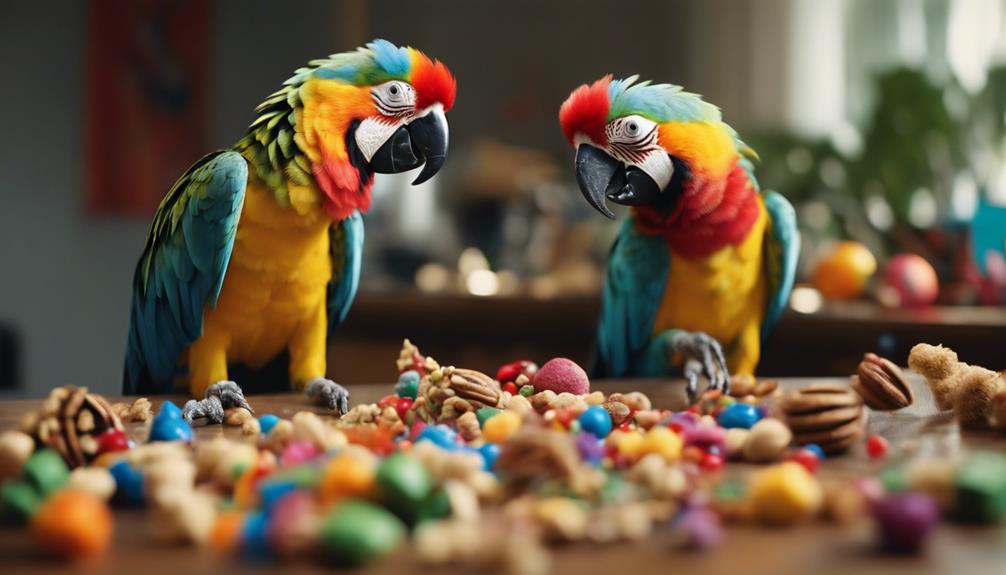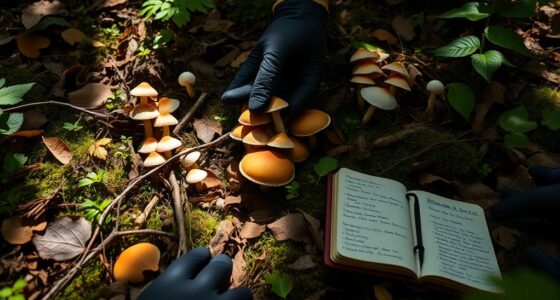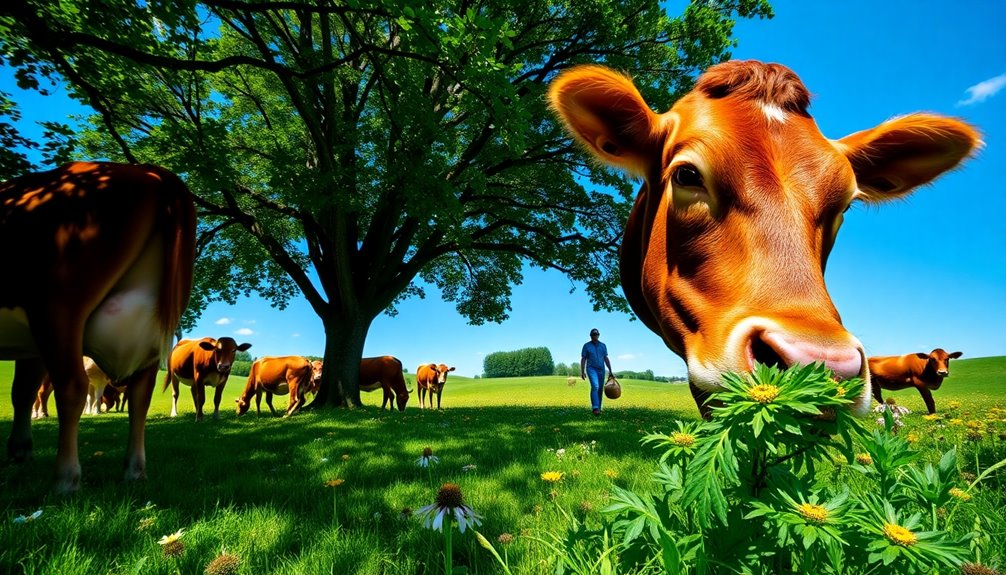To become skilled at crafting a beautiful foraging basket, begin by learning basic twining patterns using materials such as raffia. Twill weaves can create detailed designs by skipping certain steps. Select sturdy natural materials like willow for longevity. Trim branches with pruning shears, soak them to increase flexibility, and choose sizes thoughtfully. Consider the balance between form and function for both practicality and aesthetics. Customize your basket with unique embellishments like beads or dyed elements. It is crucial to have a good grasp of techniques, materials, design principles, and personalization. For additional advice on enhancing your basket-making skills, continue exploring traditional weaving methods and maintenance suggestions.
Key Takeaways
- Choose natural, flexible materials like willow for durability and intricate designs.
- Learn twining, plaiting, and twill weaving techniques for varied patterns.
- Use pruning shears to shape willow branches, soak them for flexibility.
- Consider usability, balance form and function, and focus on craftsmanship.
- Personalize with unique embellishments, weaving patterns, and decorative elements.
Weaving Techniques for Beginners
To start learning weaving techniques for beginners, explore twining basket weaving, a simple and versatile method using two pieces of like material.
Basket weaving is a traditional craft that allows you to create beautiful and functional items using natural materials. Raffia, a natural fiber derived from palm tree leaves, is an excellent alternative material for twining basket weaving techniques. This method is perfect for those beginning in basket weaving due to its straightforward approach and adaptability.
As you explore the world of basket weaving, you'll encounter various techniques such as plaiting, which involves creating diagonal weaving patterns ideal for crafting bags, pouches, and decorative items.
Twill weaving, on the other hand, focuses on intricate patterns by skipping over stakes in a specific sequence. Additionally, random weaving techniques emulate natural processes like bird nests, incorporating layering materials for a unique textured effect.
Choosing the Right Materials

When choosing materials for your foraging basket, opt for natural options like willow, reed, or bark to guarantee authenticity.
Consider the flexibility and durability of the materials to withstand outdoor use effectively.
Look for materials that are easy to manipulate and weave, allowing you to create intricate designs effortlessly.
Material Selection Tips
Consider natural materials like willow, rattan, or reed when selecting materials for your foraging basket. These materials offer strength, flexibility, and durability essential for weaving a sturdy basket that can withstand outdoor use. Opt for sustainable, locally sourced materials to align with eco-friendly practices in basket making. Look for materials with long, sturdy fibers to guarantee the structural integrity of your basket while foraging.
When choosing materials, keep in mind the aesthetics as well. Consider color variations and textures to create a visually appealing foraging basket. The combination of functionality and beauty is key in selecting the right materials for your weaving project.
Essential Tools Needed
Pruning shears are indispensable tools for cutting and shaping willow branches essential for weaving your foraging basket.
Willow branches, once cut, need to be soaked in water to make them pliable for basket weaving. Sorting these branches by size and flexibility is vital for creating a well-structured and sturdy basket.
Additionally, having a suitable work surface, like a table or flat board, provides a stable base for weaving the basket with ease and precision.
To add a touch of color and creativity to your foraging basket, consider dyeing the willow branches before weaving. This can introduce vibrant design elements to your final creation, making it truly unique.
Understanding Basket Design Principles

To understand basket design principles effectively, it's essential to grasp the intended function of the basket, whether it be for foraging or storage. When making baskets for foraging, design principles play an important role in making sure the basket meets practical needs while also being visually appealing. Factors such as material choice, size, shape, and handle design all contribute to the usability of a foraging basket.
By carefully balancing form and function, you can create a basket that not only serves its purpose efficiently but also looks pleasing to the eye.
Craftsmanship, attention to detail, and durability are key elements to take into account when designing a high-quality foraging basket. Understanding the aesthetic appeal of the basket can guide your design process and help you create a piece that's both practical and visually striking.
Adding Personal Touches to Your Basket
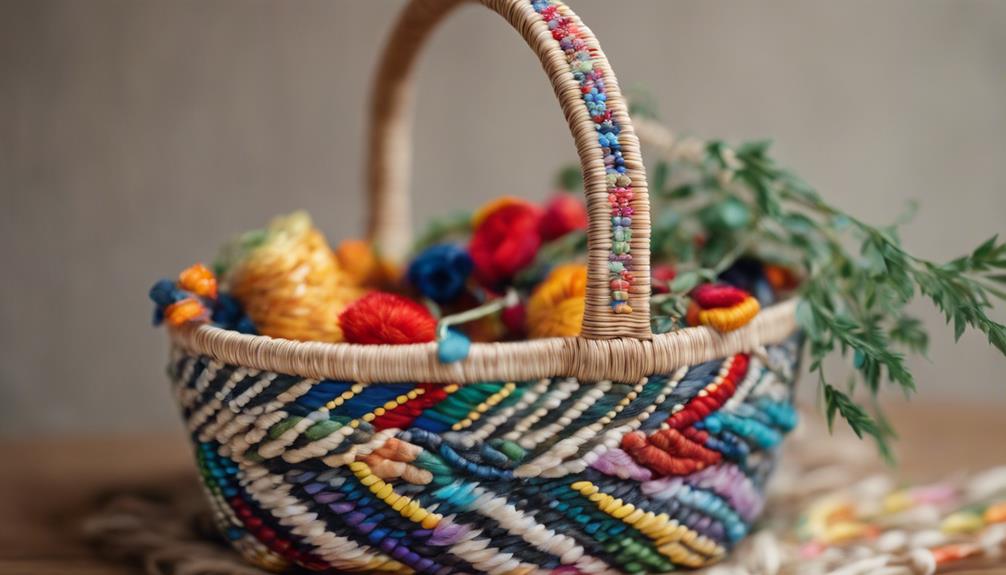
To add personal touches to your foraging basket, consider customizing it with unique embellishments like beads, feathers, or shells.
Experiment with incorporating nature into your design by using colored threads, natural dyes, or distinct weaving techniques.
Personalizing your basket with initials, symbols, or creative patterns can elevate its aesthetic appeal and make it truly one-of-a-kind.
Customizing Your Basket
Enhance the appearance of your foraging basket by infusing it with unique weaving patterns and personalized designs. When customizing your basket, consider the following:
- Experiment with Weaving Patterns:
Explore different weaving techniques such as twill or wicker weaves to add visual interest and texture to your basket.
- Add Decorative Elements:
Elevate your basket's look by incorporating colorful ribbons, beads, or shells into the design, making it truly one-of-a-kind.
- Adjust Size and Shape:
Tailor the dimensions of your basket to suit your foraging needs and personal preferences, ensuring it's both functional and aesthetically pleasing.
Embellishing With Nature
Incorporate natural elements like feathers, shells, or small stones into the weaving of your foraging basket for a personalized touch. Enhance the aesthetic appeal of your basket by adding a unique handle made from driftwood, antlers, or twisted vines. Infuse a pleasant scent and visual charm by integrating colorful flowers, dried herbs, or aromatic pine needles. For a whimsical finishing touch, attach small charms, beads, or decorative trinkets to the weaving. Experiment with different weaving patterns and textures using materials like grasses, ribbons, or yarn to create a visually striking and personalized foraging basket.
| Weaving Materials | Personalized Touch | Aesthetic Appeal |
|---|---|---|
| Feathers | Unique Handle | Colorful Flowers |
| Shells | Pleasant Scent | Dried Herbs |
| Small Stones | Whimsical Touch | Aromatic Pine Needles |
| Grasses | Decorative Trinkets | Varied Textures |
Tips for Maintaining Your Foraging Basket
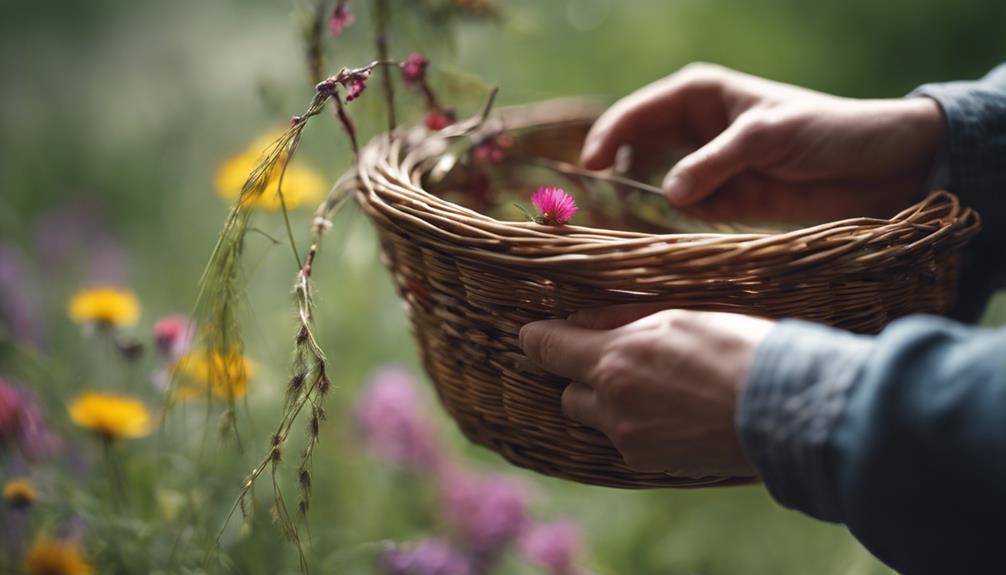
Regularly cleaning your foraging basket with a damp cloth is crucial for removing dirt and debris to maintain its quality. Keeping your basket clean not only enhances its appearance but also prolongs its lifespan.
To guarantee your foraging basket stays in top condition, follow these tips:
- Keep it dry: Prevent mold or mildew by making sure your basket stays dry after each use.
- Store it properly: Maintain the shape and durability of your basket by storing it in a cool, dry place when not in use.
- Avoid overloading: To prevent strain on the weaving and handles, refrain from overloading your basket with heavy items.
Exploring Basket Weaving Traditions
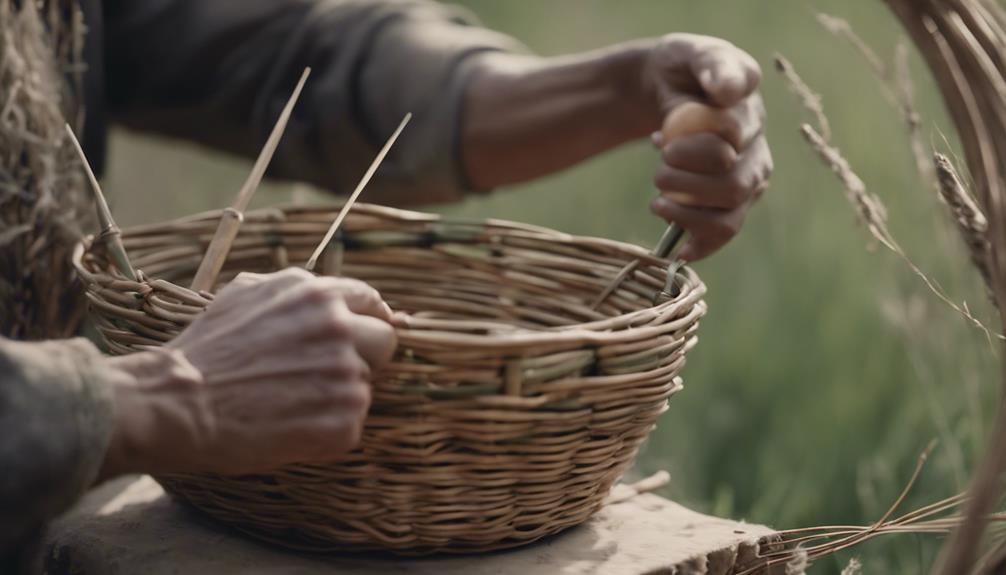
Explore the rich tapestry of basket weaving traditions across different cultures to uncover the diverse techniques and materials that have been cherished and passed down through generations. Basket weaving traditions, an ancient craft, have a long history dating back thousands of years and are deeply rooted in various cultures worldwide.
Each culture has developed unique weaving techniques and utilizes a wide range of materials, showcasing the creativity and diversity within basket making.
These traditions are more than just essential skills; they serve as a crucial link to cultural identity and heritage preservation. Passed down from one generation to the next, traditional basket weaving plays a significant role in maintaining the stories and values of communities.
Frequently Asked Questions
What Is the Art of Basket Weaving Called?
The art of basket weaving, also known as basketry or wickerwork, involves crafting baskets using natural materials. Different cultures have unique techniques for this craft. Coiling is a method where fibers are wrapped around a core to create spirals.
What Is Considered a Basket Weaving Degree?
A basket weaving degree typically includes coursework in traditional and contemporary techniques, material selection, and cultural significance. Some programs offer a specialization in basket weaving within fiber arts or crafts degrees. Graduates can pursue careers as professional basket makers or educators.
What Are the Four Techniques of Basket Weaving?
To weave a beautiful foraging basket, you must master the four main techniques: twining with two materials, plaiting for diagonal patterns, twill weaving for intricate designs, and random weaving for unique textures. Practice and enjoy!
Who Taught Mabel Mckay to Weave Baskets?
Your grandmother taught Mabel McKay to weave baskets. She learned the intricate techniques, passed down through generations. McKay's mastery was influenced by her grandmother's teachings and the rich cultural heritage of the Pomo people.
Conclusion
Congratulations on mastering the art of weaving a beautiful foraging basket! You have honed your skills and crafted a practical yet stylish accessory for your outdoor adventures.
Remember, practice makes perfect, so continue to explore different techniques and materials to enhance your basket weaving abilities. Embrace the tradition and creativity that comes with this ancient craft, and enjoy the fruits of your labor as you gather nature's treasures in your one-of-a-kind creation.
Happy foraging!


